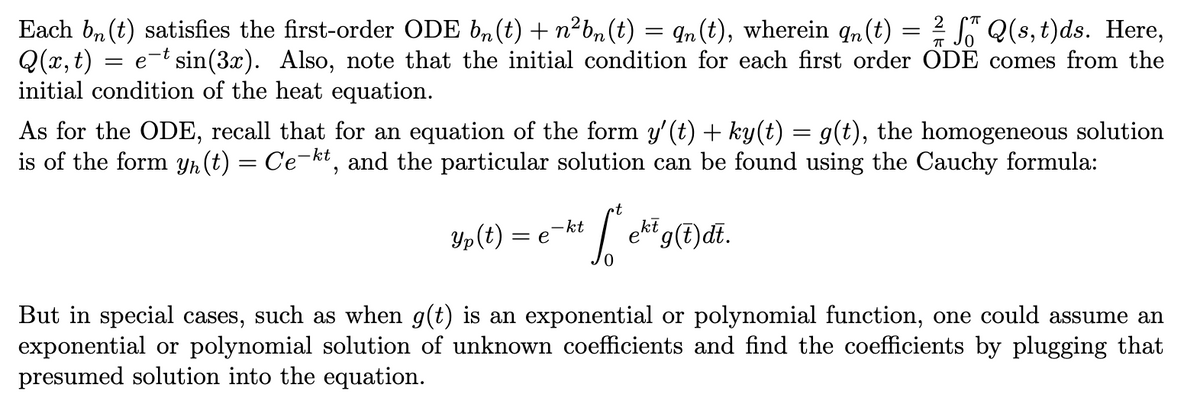2. Find the solution to the following non-homogeneous heat equation with given initial and boundary conditions on [0, π]. UtUxx = e sin (3x), u(0, t) = u(n, t) = 0, u(x,0) = sinx. Recall that for solving this boundary value problem, we solve for time-dependent Fourier coefficients bn (t) for the solution u(x, t) = bn(t) sin(nx). n=1
2. Find the solution to the following non-homogeneous heat equation with given initial and boundary conditions on [0, π]. UtUxx = e sin (3x), u(0, t) = u(n, t) = 0, u(x,0) = sinx. Recall that for solving this boundary value problem, we solve for time-dependent Fourier coefficients bn (t) for the solution u(x, t) = bn(t) sin(nx). n=1
Advanced Engineering Mathematics
10th Edition
ISBN:9780470458365
Author:Erwin Kreyszig
Publisher:Erwin Kreyszig
Chapter2: Second-order Linear Odes
Section: Chapter Questions
Problem 1RQ
Related questions
Question
![2. Find the solution to the following non-homogeneous heat equation with given initial and boundary
conditions on [0, π].
-2t
Ut
Uxx = e sin(3x),
u(0, t) = u(t, t) = 0,
u(x, 0) sin x.
=
Recall that for solving this boundary value problem, we solve for time-dependent Fourier coefficients
bn (t) for the solution
u(x, t):
∞
=Σbn(t) sin(nx).
n=1
=](/v2/_next/image?url=https%3A%2F%2Fcontent.bartleby.com%2Fqna-images%2Fquestion%2F91f76606-a4d9-42f0-be0d-7b1366a5593f%2F7b7b2b58-046e-4116-a8da-f1cc81dc6cc9%2Flkbwace_processed.png&w=3840&q=75)
Transcribed Image Text:2. Find the solution to the following non-homogeneous heat equation with given initial and boundary
conditions on [0, π].
-2t
Ut
Uxx = e sin(3x),
u(0, t) = u(t, t) = 0,
u(x, 0) sin x.
=
Recall that for solving this boundary value problem, we solve for time-dependent Fourier coefficients
bn (t) for the solution
u(x, t):
∞
=Σbn(t) sin(nx).
n=1
=

Transcribed Image Text:2
Each bn (t) satisfies the first-order ODE bn(t) + n²bn(t) = ¶n (t), wherein qn(t) = Q(s, t)ds. Here,
Q(x, t) e-t sin(3x). Also, note that the initial condition for each first order ODE comes from the
initial condition of the heat equation.
=
As for the ODE, recall that for an equation of the form y' (t) + ky(t) = g(t), the homogeneous solution
is of the form y(t) = Ce-kt, and the particular solution can be found using the Cauchy formula:
Yp(t) = e
•t
-
kt f *e²³9Ddi.
ekt
But in special cases, such as when g(t) is an exponential or polynomial function, one could assume an
exponential or polynomial solution of unknown coefficients and find the coefficients by plugging that
presumed solution into the equation.
Expert Solution
This question has been solved!
Explore an expertly crafted, step-by-step solution for a thorough understanding of key concepts.
Step by step
Solved in 4 steps with 3 images

Recommended textbooks for you

Advanced Engineering Mathematics
Advanced Math
ISBN:
9780470458365
Author:
Erwin Kreyszig
Publisher:
Wiley, John & Sons, Incorporated

Numerical Methods for Engineers
Advanced Math
ISBN:
9780073397924
Author:
Steven C. Chapra Dr., Raymond P. Canale
Publisher:
McGraw-Hill Education

Introductory Mathematics for Engineering Applicat…
Advanced Math
ISBN:
9781118141809
Author:
Nathan Klingbeil
Publisher:
WILEY

Advanced Engineering Mathematics
Advanced Math
ISBN:
9780470458365
Author:
Erwin Kreyszig
Publisher:
Wiley, John & Sons, Incorporated

Numerical Methods for Engineers
Advanced Math
ISBN:
9780073397924
Author:
Steven C. Chapra Dr., Raymond P. Canale
Publisher:
McGraw-Hill Education

Introductory Mathematics for Engineering Applicat…
Advanced Math
ISBN:
9781118141809
Author:
Nathan Klingbeil
Publisher:
WILEY

Mathematics For Machine Technology
Advanced Math
ISBN:
9781337798310
Author:
Peterson, John.
Publisher:
Cengage Learning,

